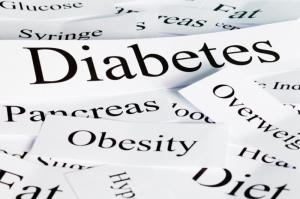
Diabetes is a disease in which your blood glucose, or sugar, levels are too high. Glucose comes from the foods you eat. Insulin is a hormone that helps the glucose get into your cells to give them energy. With Type 1 diabetes, your body does not make insulin. With Type 2 diabetes, the more common type, your body does not make or use insulin well. Without enough insulin, the glucose stays in your blood.
Over time, having too much glucose in your blood can cause serious problems. It can damage your eyes, kidneys, and nerves. Diabetes can also cause heart disease, stroke and even the need to remove a limb. Pregnant women can also get diabetes, called gestational diabetes.
Some people have no symptoms. A blood test can show if you have diabetes. Exercise, weight control and sticking to your meal plan can help control your diabetes. You should also monitor your glucose level and take medicine if prescribed.
Introduction
Diabetes is a disease that affects millions of people every year.
Your doctor may have informed you that you have diabetes. Although there is no known cure for diabetes, there are several treatments, which can control this disease.
The success of any diabetes treatment depends largely on you, the patient.
This patient education module will help you develop a better understanding of diabetes and how to control this disease.
What Is Diabetes?
The body is made of millions of cells that need energy to function.
The food you eat is turned into sugar, called glucose. Sugar is carried to the cells through the blood stream. It is one of many substances needed by the cells to make energy.
For glucose to enter the cells, two conditions must be present. First, the cells should have enough “doors,” called receptors.
Second, a substance called insulin is needed to "unlock the receptors."
Once these two conditions are met, glucose enters the cell and is used by the cell to make energy. Without energy, all cells die.
Insulin is a chemical hormone, which is manufactured in the pancreas. Insulin levels in the blood vary with the amount of glucose present in the blood.
Diabetes is a disease that makes it difficult for the cells of the body to get the glucose they need to make energy.
There are two ways in which diabetes can make it difficult for the cells of the body to receive adequate amounts of glucose. First, insulin may not be made by the pancreas. Because insulin is needed to “unlock the receptors,” glucose cannot enter the cells. Therefore, glucose levels increase in the blood. This is known as Type 1 diabetes.
Type 2 diabetes occurs when insulin is present in enough quantities, but there is a decrease in the number of receptors on the cells to allow glucose to enter. Even though insulin is present, it cannot be used effectively, a situation called “Insulin Resistance” which results in high levels of glucose in the blood.
Type 2 diabetes is more common than Type 1.
The exact causes of diabetes are unknown. However, it tends to run in families. Diabetes is not a contagious disease.
.jpg)
Signs and Symptoms of Diabetes
Diabetes is detected when your doctor or nurse finds a high level of sugar in your blood or urine. The most reliable test results are obtained when the sugar level in the blood is checked before any food or liquid is ingested. This is known as a fasting blood sugar. A range for a normal fasting blood sugar is between 70mg/dL and 120mg/dL.
Common signs and symptoms of diabetes include:
- Excessive thirst
- Frequent urination
- Excessive Hunger
- Weight loss
- Fatigue
- Changes in vision
- Slow-healing cuts or infections
- Persistent itching of the skin
If left untreated, the level of glucose in the blood can become very high, inducing coma and possibly death.
The signs and symptoms you have depend on when your diabetes is discovered and what type of diabetes you have.
please watch this video:
